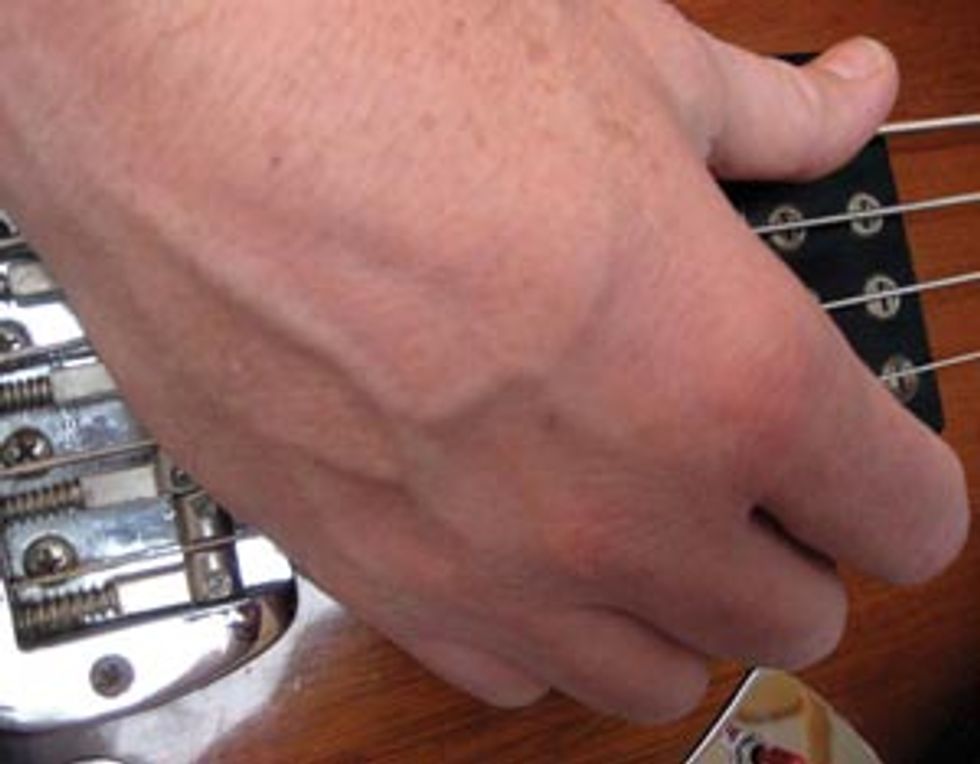Looking for upright bass sound with your electric bass? Dan has some tips...
A few years ago I was walking downtown to an outdoor concert by a local blues band. As I got closer, the sound of an upright bass wafted through the sultry evening air. I picked up my pace, eager to see who was playing such a great sounding 
Imagine my surprise when I arrived and didn’t see the big girl, but instead an electric bass played very convincingly. How can you do that? I suggest three ways that combine for a total effect.
Way #1: Think Fake!
The first key to faux upright is to think upright. If you’re already an upright bass player, you have a leg up on the whole deal. But if not, listen to some recordings of upright bass and you’ll notice:
1. Fewer notes are used to get the job done.
2. Each note carries more meaning when it’s played on upright.
3. Notes bloom from a slower, rounder attack.
4. Once a note sounds, it fades away more quickly than on an electric bass.
With these four elements of the upright sound in mind, you’re ready for Way #2.
Way #2: Play Fake!
Both left- and right-hand playing technique can help you fake that upright sound. For the right hand, you have two choices: palm muting or playing close to the neck. Palm muting produces a round attack with a darker tone, with quick decay… great for slower tunes or ones based mostly on quarter notes. Your mental image of the upright sound will be helpful in fine-tuning your sound.
The technique for palm muting involves resting the heel of your palm gently on the strings close to the bridge while plucking the strings with the fat part of your thumb. Both the amount of pressure on top of the strings and where you rest your hand make a difference, too. Experiment a bit until you find what you’re after.
Playing closer to the neck—or even over the fingerboard—can produce a different sound from your usual two-finger technique. If you play fingerstyle funk, you pluck closer to the bridge for a bright sound with a nice bite to it. Going the other way produces a rounder attack and a deeper sound. Be sure not to pluck the strings too hard when you try this. Combine this trick with a bit of help from your left hand to control a note’s duration. To do this, damp the note after the initial attack by raising your finger off the fingerboard.
One last technique trick is to play notes up higher on a fatter string. For example, play a B-flat on the sixth fret of the E string, instead of the first fret of the A string—you’ll have a fatter sound with more emphasis on the fundamental and less of the upper harmonics.
Way #3: Process the Fake!
Okay. You’ve seen how getting an upright sound out of a fretted electric bass comes from a combination of mindset and playing technique—that gets you eighty percent of the way to your goal. To push the fauxupright effect a bit further, do a little electronic tweaking of the sonic qualities. The most simple of these is to roll off the tone control of your electric bass at least half way to eliminate finger noise and high frequencies that give away your upright ruse.
You can enhance your EQ trickery at the amp by bumping the low mids (around 100 Hz) while reducing the upper mids (1kHz) and highs. You don’t need a huge fundamental, but the tone should be smooth and thick sounding. One last trick is to use a somewhat heavy dose of a limiter or compressor to knock down the front edge of the note and then let it swell up as it releases.
Off to the Woodshed!
So there you have it: three ways to fake a big, thumpy upright bass if the need arises. Now you just need some practice. Of course, if you’re trying to get a bowed sound or develop that growly, modern upright jazz style, these tips won’t get you there. And of the three ways, I’d have to say that the mental image of an upright bass is most crucial. If you have that part worked out, the playing technique will follow.
Dan Berkowitz
Dan is a professor by day and a bass player when the sun goes down. He plays both electric and upright bass in blues, jazz and pit setting.

